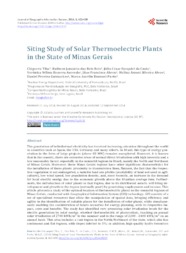Siting study of solar thermoelectric plants in the State of Minas Gerais.
Siting study of solar thermoelectric plants in the State of Minas Gerais.
Author(s): TIBA, C.; REIS, R. J. dos R.; COSTA, J. C. E. da; AZEVEDO, V. W. B.; ABREU, J. F.; ALVES, M. A. S.; GUIMARAES, D. P.; PORTO, M. A. D.
Summary: The generation of heliothermal electricity has received increasing attention throughout the world in countries such as Spain, the USA, Germany and many others. In Brazil, this type of energy generation in the form of large projects (above 80 MW) remains unexplored. However, it is known that in the country, there are extensive areas of normal direct irradiation with high intensity and a low seasonality factor, especially in the semiarid regions in Brazil, mainly the North and Northeast of Minas Gerais. Moreover, these Minas Gerais regions have other significant characteristics for the installation of these plants: proximity to transmission lines, flatness, the fact that the respective vegetation is not endangered, a suitable land use profile (availability of land not used in agriculture), low wind speed, low population density, and, most recently, an increase in the demand for local electric energy due to the economic growth above the Brazilian average rate. Furthermore, the introduction of solar plants in that region, due to its distributed nature, will bring development and growth to the region (normally poor) by generating employment and income. This article presents a study of the optimal location of thermoelectric plants in the semiarid regions of Minas Gerais, conducted with Geographical Information System (GIS) technology. GIS consists of a set of specialised resources that allow the manipulation of spatial data, bringing efficiency and agility in the identification of suitable places for the installation of solar plants, while simultaneously enabling the consideration of future scenarios for energy planning, with its respective impact, costs and benefits. The study has identified very promising solar irradiation levels for the electric generation by solar energy, whether thermoelectric or photovoltaic, reaching an annual solar irradiation of 2700 kWh/m² in the summer and in the range of 2200 - 2400 kWh/m² on an annual basis. This area includes a vast region in the North/Northeast of the state, which also has continuous and flat regions, with slopes inferior to 3%; in addition, high-quality hydro resources are abundant and well distributed. Furthermore, the Minas Gerais region has few areas with high agriculture profile and reduced quantity of protected units. Therefore, generally speaking, the coverage of the transmission lines in that region is suitable. Considering the most relevant aspects mentioned before, and taking as a reference the micro-region limits defined by the IBGE, the following micro-regions were classified as the most promising ones: 1) Janaúba, 2) Januária, 3) Pirapora and Unaí, 4) Pirapora and Paracatu, 5) Curvelo and Três Marias, and 6) Patrocínio and Araxá. Finally, it is important to highlight that this potential might be explored gradually in the medium term, with the shortage of other supply sources, the scale up and readiness of such technologies, as well as the creation of a complex solar-wind-hydro system that leverages the strong complementarity of such resources, as has been observed.
Publication year: 2014
Types of publication: Journal article
Unit: Embrapa Maize & Sorghum
Observation
Some of Embrapa's publications are published as ePub files. To read them, use or download one of the following free software options to your computer or mobile device. Android: Google Play Books; IOS: iBooks; Windows and Linux: Calibre.
Access other publications
Access the Agricultural Research Database (BDPA) to consult Embrapa's full library collection and records.
Visit Embrapa Bookstore to purchase books and other publications sold by Embrapa.

